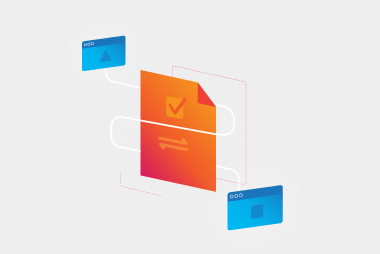If you’re new to EDI, you might be a bit overwhelmed with all the new terms, acronyms and the like. You’ve probably come across EDI standards, like EDIFACT or EANCOM, and have no idea what they mean. Well, you’re in the right place. In this blog, we’ve put together some information around EDI, its different message standards and the ones that are commonly used in Australia.
What are EDI messages?
In simple words, EDI messages are business documents, often procurement-related, exchanged between companies’ software, perhaps through EDI provider(s) in the middle. These documents are often exchanged in a standardised format to make it easier to communicate with all of your trading partners. These messages can be purchase orders, despatch advices, invoices and more.
Why use standards?
EDI message standards define the rules and requirements for the structure and format of an EDI message. These standards are defined by various organisations like GS1 and Peppol. Organisations choose to exchange data in a standard format because it makes it much easier for their trading partners to get on board. If everyone exchanged a different file format, onboarding one trading partner to EDI would be like starting from scratch every time.
What are the different EDI message standards and what EDI message standards are commonly used in Australia?
There are different EDI message standards used around the world. Some of the most popular ones are UN/EDIFACT, ANSI X.12, EANCOM, ODETTE, ebXML, TRADACOMS, HIPAA, and SWIFT.[vc_column width="1/4" css=".vc_custom_1618271818355{padding-right: 10px !important;}"]
UN/EDIFACT
ANSI X.12
EANCOM
ODETTE
EbXML
TRADACOMS
HIPAA
SWIFT
[vc_column width="3/4" css=".vc_custom_1618271827363{padding-left: 10px !important;}"]
Standard coined by the United Nations and the most commonly used worldwide.
Commonly used in North America
Commonly used in the European retail industry
Commonly used in the European automotive industry
Global standard developed by United Nations body for Trade Facilitation and Electronic Business Information Standards (UN/CEFACT) and Organization for the Advancement of Structured Information Standards (OASIS ).
Commonly used in the UK retail industry
Commonly used in the North American Healthcare industry
Commonly used by financial institutions worldwide.
Out of the many EDI standards, the ones that are commonly used in Australia are UN/EDIFACT, ANSI.X12 and GS1 XML. Let’s have a look:[vc_column width="2/4" css=".vc_custom_1618271818355{padding-right: 10px !important;}"]
Transaction
Purchase order
Purchase order response
Invoice
Despatch advice
Remittance advice
Product catalog
Functional acknowledgement
[vc_column width="1/4" css=".vc_custom_1646013227774{padding-right: 10px !important;padding-left: 10px !important;}"]
UN/EDIFACT
ORDERS
ORDRSP
INVOIC
DESADV
REMADV
PRICAT
CONTRL
[vc_column width="1/4" css=".vc_custom_1646013158821{padding-left: 10px !important;}"]
ANSI X.12
850
855
810
856
820
832
997
What to do if your software doesn't exchange these standards?
Don’t worry – this isn’t uncommon. If your software doesn’t produce these standards, we can help you map them. This means we’ll translate files produced by your software to the standard required, mediating between message standards and protocols and aligning business processes.
Industry-specific:
Retail (supply chain)
The retail industry in Australia has taken advantage of the benefits of EDI over the last 30 years. The industry uses EDI for procurement as well as shipping and logistics. UN/EDIFACT dominate the as the standard used in the retail sector. If you’re interested to read more about EDI in the Australian retail industry, click here.
Transport and logistics
The Australian Logistics Council and GS1 Australia developed the Australian Freight Labelling and EDI standards in 2016. The GS1 Open Global supply chain standard requires each shipment label to have a ‘license plate’ known as the SSCC code. SSCC - serial shipping container code - is a common identification among the buyers and suppliers of the transport and logistics industry in Australia. In addition to the common EDI messages like the purchase order, purchase order response, invoice, this sector uses EDI to share information about booking as well as tracking details. The transport and logistic industry commonly uses GS1 XML standard to exchange EDI documents.
Finance
The finance industry uses EDI to transfer payments, information related to payments and other financial documents. ISO20022 is the format used by MessageXchange for our customers in the finance industry. ISO20022 is an internationally-recognised standard developed by ISO. It is used for the development of financial EDI messages in the payments, securities, cards, trade services and foreign exchange business domains.If you want to learn more about EDI for your business, request a call back from our EDI experts below.
Request a call
Chat with one of our experts
Just fill out your details below and we'll be in touch within one business day.
 If you choose to go with our FormXchange product, you can even automate the process one step further. By turning on the integration between FormXchange and Xero, you can sync the invoices you enter in the EDI portal (FormXchange) directly to Xero, so your invoices are always up-to-date in your accounting software.
That means whenever you send an invoice to your customer on FormXchange, a copy will go to them, as well as to your Xero account. It’s that simple.
If you choose to go with our FormXchange product, you can even automate the process one step further. By turning on the integration between FormXchange and Xero, you can sync the invoices you enter in the EDI portal (FormXchange) directly to Xero, so your invoices are always up-to-date in your accounting software.
That means whenever you send an invoice to your customer on FormXchange, a copy will go to them, as well as to your Xero account. It’s that simple.






